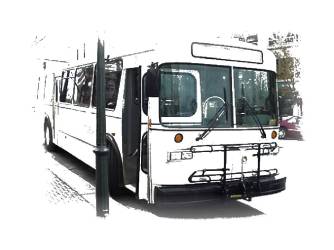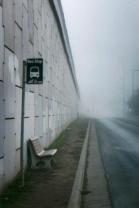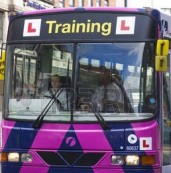
I realise I haven’t written this blog for quite a long time. This is because I have been so busy day to day just getting into the routine of the job. I keep meaning to write, but life gets in the way. So I thought I would write “A Day in the Life” to show the sort of things I do all day.
At 07:53 I start my shift. I never start at o’clock or half past or any logical sounding time. I clock on exactly 15 or 20 minutes before my first bus is due out, depending on whether I have to carry out a “First Use Check.”
This morning, I’m doing a first use check. This means going into the office where a supervisor marks me present on his computer and hands me a duty card. I then trudge (cold and dark this time of year) around the back to the garage. A number on my duty card corresponds with an allocated bus which I can find on a dry-wipe board. A map then shows me the precise location of my bus in the grid of parked buses (they form roughly a 4 by 8 rectangle of buses packed tightly side by side and nose to tail. Some of our larger drivers have trouble squeezing through…). The grid is carefully planned so that the earliest buses are nearest the front. When all is going to plan, the buses in front of yours have left or are just about to.
I find my bus and press the button to open the doors. Nothing happens. This means one of two things; either the air pressure in the tanks is low or the battery is dead, or both! I force one door, flip on the power, check I’m in neutral and press the starter. For a heart stopping moment, nothing seems to happen, then the engine roars into life. The battery is clearly fine, the beeping dash tells me what I already know – my air pressure is low. The air tanks operate the brakes, suspension and doors so they are crucial, but a few revs gets them charged up, and the doors decide they will open now.
After filling in some details about myself and the bus on a defects card, I proceed to walk around the bus checking everything on my list. This includes lights, wheels, mirrors, wipers and many other things around the outside, then lighting and seating, safety equipment etc in the saloon (where the passengers sit). I have a tick list on the card to complete to make sure everything is in working order. Today, a parking light bulb is out, so I trudge back to the workshop to tell the supervisor and get someone sent to replace it. Meanwhile, the guy in the vehicle behind mine is looking at his watch; it’s not just my bus that will be held up if the problem can’t be resolved quickly.
Bulbs are easy, however, and I’m quickly underway. Today I’m not starting in the bus station, but going out “dead” to start an inbound journey. I love driving along with the “Not in Service” sign showing at the front of the bus; I can take short cuts and drive as fast as I like (safely and within speed limits of course) as I have no passengers to worry about. I reach my starting point with a couple of minutes to spare, and set up the destination blind so it now shows my route number and destination. Once I have logged in to the ticket machine and programmed the correct journey into it, I’m ready to go!
Because it’s early, I manage to go a couple of stops before I find some passengers to collect. I manage a particularly cheery good morning as they board, because even though I only started the engine half an hour ago, the air blowers are starting to blow warm already, and that puts me in a good mood; some buses seem to take an hour or more to warm up, while one or two have no heating working. Hard cheese if that’s the case; if the blowers are doing their job of clearing the windscreen, they’re legal, hot or not!
Because it’s a Saturday, I’m not too busy this early, and I get the bus back in plenty of time. In fact, I have to pause at one of the stops and wait. My duty card has a list of timing points that I must not get ahead of. If I start to run early, I simply stop and wait until the time on my card matches the time on my ticket machine, then set off once more.
This particular route is a circular. Having started from the halfway point, I now have two more full circuits to run before my break. This is a short day – it is more common to have to do four of these circuits before a break. The next two circuits pass without incident, apart from the fact that everybody seems to have ten pound notes, eating up my float. I have explained how we have to maintain our own float in one of my earlier blogs, so you can appreciate how annoying it is for me, giving away all my coins. On my final return to the bus station, I log off the ticket machine and sign myself off the defect card, circling the box to say there have been no defects arising en route, then leave the bus ready for the next driver.
After an hour’s break, which I spend in the staff room chatting with the other drivers as they come in and out on their various breaks, I now switch routes. I’m no longer doing the circular, but taking a bus to a hospital in the neighbouring town and back, an hour each way, done twice (so a four hour stint). Before I have to start, I pay an extra visit to the loo in the hope I will then be able to hold on for the duration.
At the station, my bus is nowhere to be seen; it isn’t back from its previous trip yet. The sun is out and the traffic has built up which doesn’t bode well for the smooth running of the second half of my shift. Another vehicle is found for me and I’m underway on time. Halfway up the hill out of town I pass the guy whose bus I was supposed to have on his way down, and give him a cheery wave.
It doesn’t take me long to find out what kept him. I am held up for over five minutes queueing at the roundabout for John Lewis. The unexpected mild and sunny day has brought everyone out of hibernation and they’re all driving to the shops. This queue is repeated at every shopping centre between home and the hospital. I get there ten minutes late, then have to fight my way back through it all again! For the first time this year (well, it is only February) I get hot enough to ditch my jumper and put my sunglasses on to protect myself from the unaccustomed glare of sunlight on my white shirt.
By the time I get back to the bus station I’m over twenty minutes late – it’s a good job I paid that visit earlier – and as fast as I can I reprogram the ticket machine and get my next load of passengers on board. I stop looking at my duty card at this point; knowing how late I am will only make me want to rush, and that’s when errors happen, as I have learnt to my cost (more on that another day). I put on my four way flashers, a signal to the banksmen I’m ready to leave, and one of them approaches to guide me back out of the bay.
Without a single glance at my card, I fight my way back up the hill, back through the John Lewis traffic and all the other hotspots and back to the hospital. Only then do I dare to check the card – I’m only just over ten minutes late! Somehow I’ve managed to claw back some time. It’s now mid afternoon, the sun has found a new bank of clouds to hide behind and the traffic is thinning out. After a quick sip from my water bottle and a change of glasses I start my final inbound journey of the day. Again, I ban myself from looking at the card until I’m on the last leg of the trip. Miraculously, I bring her in to the bus station just two minutes late, where the next driver is waiting to take her out again. He was my mentor during training, so we chat while I log myself out of the ticket machine, sign off the defect card (no defects to report) and he adjusts the seat and signs himself on.
I haven’t quite finished my day. I now have to go to one of the machines to pay in my day’s takings. I have a paltry amount today because I didn’t carry many commuters (it being a Saturday) and most of my passengers had passes or pre-paid tickets. The readout from the ticket machine declares that I have £79.60 to pay in. A good day (on a more popular route during the week) could see me taking over double or triple that amount. But I have another problem. I may only owe £79.60, but I have £85 in notes and a rather depleted float. To give the correct amount, I would have to put in £75 in notes, then deplete my change further to pay the rest. Instead, I choose to make an over-payment and shove £80 into the machine. The difference will come back to me in my pay packet next week or the one after. If I under pay (because, for example, I make a mistake with change and my takings are down) this gets deducted from my pay. Funnily enough, we’re all really careful giving out change!
Now, at last, I am done for the day, and I’ve had a good one. Even though my bus was really late at one point, nobody has grumbled at me and because today was a shorter shift than usual, I’m away home with time and energy to spare. I’ve a day off tomorrow, then I’m on early Monday, when all the commuters will want to buy their weekly passes from me, and no matter how much they slow me down serving them, they will grumble if we’re late…








 The last two weeks on the course have been really quite hard. After the initial flurry of “beginner’s luck” progress, I seemed to hit some kind of wall (only metaphorically, I hasten to add) and suddenly it seemed as though I just couldn’t get it at all. I ended up in a vicious cycle; something would go wrong, I would become anxious, something else would go wrong and the anxiety deepened, causing further mistakes. For a little while, I wasn’t sleeping well, and my stomach would flip flop with dread when my turn came to get behind the wheel.
The last two weeks on the course have been really quite hard. After the initial flurry of “beginner’s luck” progress, I seemed to hit some kind of wall (only metaphorically, I hasten to add) and suddenly it seemed as though I just couldn’t get it at all. I ended up in a vicious cycle; something would go wrong, I would become anxious, something else would go wrong and the anxiety deepened, causing further mistakes. For a little while, I wasn’t sleeping well, and my stomach would flip flop with dread when my turn came to get behind the wheel.